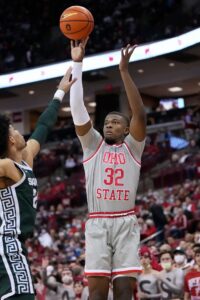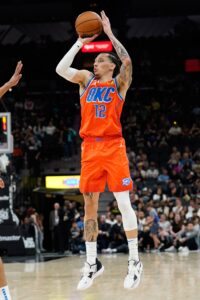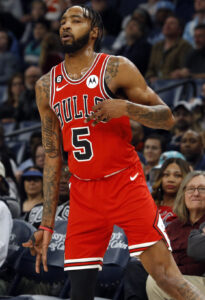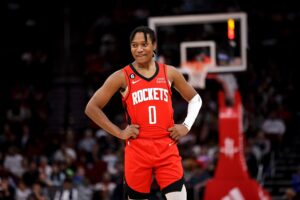A new addition in the NBA’s 2017 Collective Bargaining Agreement, the two-way contract is a tool that allows a team to carry extra players beyond the 15 on its standard regular season roster. Players on two-way contracts are eligible to spend up to the entire season in the G League or up to a certain number of games at the NBA level, and can be transferred back and forth between the NBA and NBAGL throughout the season.
The rules for two-way contracts have undergone some major changes since the concept was introduced back in 2017, with the COVID-19 pandemic contributing to some of those tweaks. The league loosened certain restrictions and allowed two-way players to be more available to teams that needed extra bodies during the pandemic — many of those changes have stuck and were ratified in the 2023 CBA.
Given those changes, our glossary entry on the two-way contract is due for an update, so let’s dive in and answer some frequently asked questions about the two-way deal…
Who is eligible to sign a two-way contract?
A player with fewer than four years of NBA experience can sign a two-way contract with a team. Because a player is credited with a year of service on the last day of a league year (ie. June 30), a player with three years of experience is eligible to sign a two-way contract at any time during his fourth NBA season. For instance, a player who is waived halfway through his fourth NBA season is still deemed to have three years of service and could sign a rest-of-season two-way contract.
As part of the 2023 CBA, the league and the players’ union agreed to implement what is informally known as the “Harry Giles rule.” Giles has been on an NBA roster for four seasons, but missed the entirety of his 2017/18 rookie year due to an injury, so he has only actually played in an NBA regular season game in three separate seasons.
The new rule will allow Giles – and any other player who has four years of NBA service but missed one or more of those seasons due to an injury – to sign a two-way contract, assuming the player meets the following criteria:
 He has four years of NBA experience (ie. a player with five years of experience who missed two full seasons due to injuries would not be eligible).
He has four years of NBA experience (ie. a player with five years of experience who missed two full seasons due to injuries would not be eligible).- He didn’t appear in any regular season or playoff games during his injury year.
- During his injury year, he was on a team’s roster for the entire regular season.
- He is signing a one-year two-way contract.
Dylan Windler is another example of a player who qualified for a two-way contract in 2023/24, having met the above criteria during his first four NBA seasons. That’s why he was permitted to sign a two-way deal with the Knicks.
How many years can a two-way contract cover?
A two-way contract can be for either one or two years, and can’t include a team or player option.
Although two-way contracts can be for up to two years, a player who has three years of NBA experience can’t sign such a deal, since he’d have four years of service after the first season. As such, two-way contracts for players with three years of experience are limited to one year.
A player also can’t spend more than three total seasons on two-way contracts with the same team. For example, a player who signed two-way deals with a club during his first two NBA seasons couldn’t then agree to a two-year two-way contract with the same team.
How much are players paid on a two-way contract?
The default salary for a full one-year, two-way contract is half of the rookie minimum salary. For example, since the 2023/24 rookie minimum is $1,119,563, the two-way salary is $559,782. No performance bonuses can be included in a two-way agreement.
That two-way salary becomes prorated if a player signs his contract after the regular season has began. Since the 2023/24 regular season is 174 days long, if a player were to sign a two-way deal with 120 days left in the season, his salary would be $386,057 — that’s 120/174ths of $559,782.
A two-way deal signed before the regular season begins can be partially guaranteed for up to the maximum Exhibit 10 bonus amount for that year. In 2023/24, that amount – also known as the maximum two-way protection amount – is $75K.
A team and player can negotiate to have up to half of his two-way salary become guaranteed at the start of the regular season. If the two sides agree to those terms, the player would receive half his two-way salary assuming he’s not waived on or before the first day of the regular season. Each player’s full two-way salary would become guaranteed if he remains under contract through January 7, and each two-way deal signed after that date is immediately guaranteed.
How do two-way contracts work for the teams signing them?
While a player who signs a G League contract to play for a team’s NBAGL affiliate remains an NBA free agent and can be signed away by any other team, a club that signs a player to a two-way deal has the player’s exclusive rights for the life of the contract. He can’t be poached by a rival team.
A team gets up to three roster slots for two-way contracts, and doesn’t need to use salary cap room or a cap exception to finalize those deals. They don’t count against a club’s salary cap.
However, there are some limitations facing teams when they sign two-way contracts. For one, if a club wants to sign a player on an overseas roster to a two-way contract, the NBA team is not allowed to pay that player’s international buyout. Additionally, NBA teams can’t sign players to two-way contracts after March 4 of each season.
How many games can a player on a two-way contract play for his NBA team?
If a player is on a two-way contract, he can be active for no more than 50 regular season games, or a prorated portion of 50 games, if he signs after the regular season begins.
For the purposes of determining the maximum active games for a two-way player who signs after the start of the regular season, the number of days left in the season are divided by the total number of days in the season, then multiplied by 50 and rounded to the nearest whole number.
A team isn’t permitted to have a two-way player active for more than 90 “under-15” games in a season. An “under-15” is any game in which the team is carrying fewer than 15 players on standard contracts, and a team is credited with an “under-15” game toward the 90-game limit for each two-way player who is active.
For instance, if a team with 14 players on standard contracts had all three of its two-way players active for its first 30 games of the season, it would reach its 90-game limit. In order to free up those two-way players to be active for 20 more games apiece, the club would have to sign a 15th player to a standard contract.
If a team wants to keep its two-way player on the NBA roster for more than 50 regular season games, it has to convert the player’s two-way deal into a standard NBA contract, after which he’d no longer count as a two-way player.
Additionally, a player on a two-way contract must have his deal converted to a standard NBA contract in order to participate in the postseason. A player on a two-way deal isn’t playoff-eligible.
How do two-way conversions work?
There are two types of two-way conversions:
1. A player being converted from an Exhibit 10 contract to a two-way contract
A player on an Exhibit 10 contract can only be converted to a two-way deal up until the day before the regular season begins.
The player must have an Exhibit 10 clause in his contract in order to be converted to a two-way deal. A player on a non-guaranteed training camp contract that only includes Exhibit 9 (not Exhibit 10) language cannot be directly be converted to a two-way deal and would be have to be waived and then re-signed if the team wants to make him a two-way player.
A player can be waived from a standard contract and re-signed to a two-way deal as long as he meets the service time criteria and isn’t already owed more than the two-way protection amount ($75K in 2023/24) from his team.
For example, although Dalano Banton only has two years of NBA experience, the Celtics wouldn’t be able to waive him and re-sign him to a two-way contract because his deal with the team includes a $200K partial guarantee.
2. A player being converted from a two-way contract to a standard contract
 A player on a two-way contract can be converted without his consent. In that scenario, he would receive the minimum salary for the remaining term of his contract. A player on a one-year two-way contract would get a one-year, minimum-salary standard contract, while a player with two years left on his two-way deal would get a two-year, minimum-salary standard contract.
A player on a two-way contract can be converted without his consent. In that scenario, he would receive the minimum salary for the remaining term of his contract. A player on a one-year two-way contract would get a one-year, minimum-salary standard contract, while a player with two years left on his two-way deal would get a two-year, minimum-salary standard contract.
Alternately, the team and player could negotiate new terms that include more than one or two years and/or more than the minimum salary. In this scenario, the club would have to use either cap room or a cap exception to accommodate the terms of the deal. For instance, when the Pelicans negotiated a standard contract with two-way player E.J. Liddell earlier this offseason, they used a portion of their mid-level exception to give him three years.
In a situation where a two-way contract is converted to a regular NBA deal, the typical 15-man roster rules would apply to that player. He could be assigned back to the G League, but he’d continue to earn an NBA salary, since he’d no longer be a two-way player.
Can players on two-way contracts be traded?
Players on two-way contracts can be included in trades. However, they can’t be dealt within 30 days of being signed, and their salaries don’t generate trade exceptions for NBA teams.
In actuality, trades involving players on two-way contracts hardly ever occur. It has only happened twice to date. Johnathan Motley was traded from the Mavericks to the Clippers in 2018 and Julian Washburn was traded from the Grizzlies to the Warriors in 2019.
How does free agency work for a player whose two-way contract is expiring?
Nearly every player completing a two-way contract is eligible for restricted free agency. If his team issues him a qualifying offer by 5:00 pm Eastern time on June 29, he becomes a restricted free agent; if his team declines to issue a qualifying offer by that deadline, he becomes an unrestricted free agent.
The qualifying offer for a player coming off a one-year two-way contract is equivalent to another one-year two-way contract, with a partial guarantee worth the maximum two-way protection amount ($75K in 2023/24).
However, the qualifying offer looks a little different for a player who has spent the last two seasons on the same two-way contract; who has spent the last two years on two-way deals with the same team; or who is no longer eligible for a two-way contract because he has four years of NBA experience.
The qualifying offer in that case would be for the player’s standard veteran minimum (based on his years of experience) and would be partially guaranteed for the standard/two-way QO protection amount ($90K in 2023/24).
The maximum two-way protection amount ($75K) and the standard/two-way QO protection amount ($90K) will increase at the same rate as the salary cap in 2024/25 and beyond. So if the cap rises by 10%, those figures will also rise by 10%.
A two-way player who is issued a qualifying offer has the same options as a standard restricted free agent. He can sign a standard offer sheet with another team, negotiate a new deal with his current team, or simply accept his QO.
An offer sheet with a rival suitor would have to be a standard deal, not another two-way contract. The same rules that would apply to a standard RFA’s offer sheet apply to one for a two-way player — for instance, it must cover at least two years, and players with only one or two years of experience are subject to the Gilbert Arenas provision.
A two-way player is ineligible to receive a qualifying offer only if he’s a former first-round pick whose third- or fourth-year rookie scale team option was declined.
Note: This is a Hoops Rumors Glossary entry. Our glossary posts will explain specific rules relating to trades, free agency, or other aspects of the NBA’s Collective Bargaining Agreement. Larry Coon’s Salary Cap FAQ and information from ESPN’s Bobby Marks was used in the creation of this post.
A previous version of this article was published in 2017.
 5:08pm:
5:08pm:  “We are excited to welcome Derrick to Dallas,” said GM Nico Harrison. “Derrick has always showcased a team-first approach with his ability to adapt his game to complement his teammates. His versatility on both ends of the floor will allow us to utilize his skillset and athleticism in a variety of different lineups.”
“We are excited to welcome Derrick to Dallas,” said GM Nico Harrison. “Derrick has always showcased a team-first approach with his ability to adapt his game to complement his teammates. His versatility on both ends of the floor will allow us to utilize his skillset and athleticism in a variety of different lineups.” The 29th overall pick in the 2022 draft, Washington appeared in 31 games as a rookie with the Rockets last season, averaging 4.7 points, 1.5 assists, and 1.5 rebounds in 14.0 minutes per night. He put up an underwhelming shooting line of .363/.238/.556 in those 31 games.
The 29th overall pick in the 2022 draft, Washington appeared in 31 games as a rookie with the Rockets last season, averaging 4.7 points, 1.5 assists, and 1.5 rebounds in 14.0 minutes per night. He put up an underwhelming shooting line of .363/.238/.556 in those 31 games. He has four years of NBA experience (ie. a player with five years of experience who missed two full seasons due to injuries would not be eligible).
He has four years of NBA experience (ie. a player with five years of experience who missed two full seasons due to injuries would not be eligible). A player on a two-way contract can be converted without his consent. In that scenario, he would receive the minimum salary for the remaining term of his contract. A player on a one-year two-way contract would get a one-year, minimum-salary standard contract, while a player with two years left on his two-way deal would get a two-year, minimum-salary standard contract.
A player on a two-way contract can be converted without his consent. In that scenario, he would receive the minimum salary for the remaining term of his contract. A player on a one-year two-way contract would get a one-year, minimum-salary standard contract, while a player with two years left on his two-way deal would get a two-year, minimum-salary standard contract.